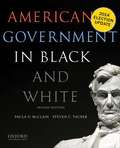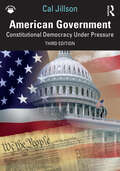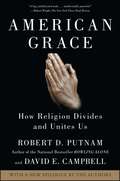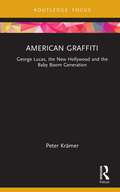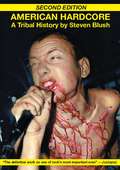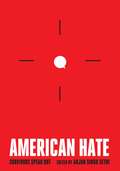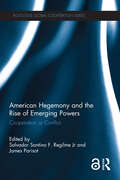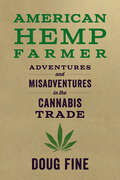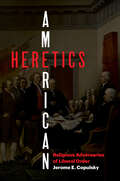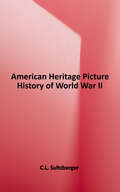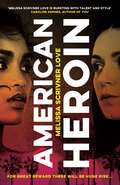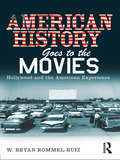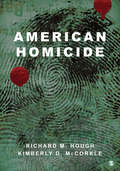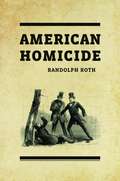- Table View
- List View
American Government in Black and White (Second Edition)
by Paula D. Mcclain Steven C. TauberConcise, affordable, and engaging, American Government in Black and White, Second Edition, 2014 Election Update, is a unique introduction to American government that uses racial and ethnic equality as its underlying theme. Authors Paula D. McClain and Steven C. Tauber address issues of inequality in major facets of government, including the U. S. Constitution, key American political institutions and instruments of political behavior, and the making of public policy. Engaging the original voices of racial and ethnic actors in our nation's history, they show students how to measure and evaluate the importance of equality in America, from its founding up to today. FEATURES * Three kinds of text boxes that help students develop empirical and qualitative analytical abilities: "Measuring Equality," "Evaluating Equality," and "Our Voices" * Vignettes, illustrations, and case material that connect America's past and present * Running glossary definitions, thematic chapter conclusions, probing review questions, and annotated additional readings highlighting writings by and about racial and ethnic minorities
American Government: Constitutional Democracy Under Pressure
by Cal JillsonAmerican Government: Constitutional Democracy Under Pressure highlights the dangerous tension between our constitutional principles and institutions and the populist heat that sometimes roils our national politics, including at the current political moment. Our constitutional democracy has been under pressure for some time, but few would deny that fears for its fate have deepened in just the past few years. We assume that our political institutions will limit and contain contemporary populism, just as the Founders intended and as they have in the past, but will they? An increasingly polarized electorate, urging their representatives to fight and never to compromise, may be stressing Constitutional limits. This new edition offers to help American government teachers lead their students to a nuanced theoretical and practical understanding of what is happening in the politics of their Constitutional democracy today.New to the Third Edition Further develops and highlights the distinguishing theme of the book, “Constitutional Democracy Under Pressure,” in light of the Trump and Biden administrations. Expands coverage of all media aspects including fake news, social media, responsible journalism, and related topics including foreign manipulation of the news. Describes numerous ways in which the American political system has been affected by the recovery from the Covid-19 pandemic, inflation, and security concerns. Evaluates the evidence for increasing polarization in public opinion, voting behavior, and legislative politics. Explores the implications of recent Supreme Court decisions including controversial rulings on reproductive health, the separation of church and state, the environment, and presidential powers. Includes the most recent election results. Updates in all tables, figures, suggested readings plus photo updates throughout.
American Government: Institutions and Policies (AP) 11th Edition)
by James Q. Wilson John J. Diiulio Jr.The guide includes chapter focus, study outlines, "Did You Think That...?" and practice questions with answers.
American Grace: How Religion Divides and Unites Us
by Robert D. Putnam David E. CampbellAmerican Grace is a major achievement, a groundbreaking examination of religion in America. Unique among nations, America is deeply religious, religiously diverse, and remarkably tolerant. But in recent decades the nation's religious landscape has been reshaped. America has experienced three seismic shocks, say Robert Putnam and David Campbell. In the 1960s, religious observance plummeted. Then in the 1970s and 1980s, a conservative reaction produced the rise of evangelicalism and the Religious Right. Since the 1990s, however, young people, turned off by that linkage between faith and conservative politics, have abandoned organized religion. The result has been a growing polarization--the ranks of religious conservatives and secular liberals have swelled, leaving a dwindling group of religious moderates in between. At the same time, personal interfaith ties are strengthening. Interfaith marriage has increased while religious identities have become more fluid. Putnam and Campbell show how this denser web of personal ties brings surprising interfaith tolerance, notwithstanding the so-called culture wars. American Grace is based on two of the most comprehensive surveys ever conducted on religion and public life in America. It includes a dozen in-depth profiles of diverse congregations across the country, which illuminate how the trends described by Putnam and Campbell affect the lives of real Americans. Nearly every chapter of American Grace contains a surprise about American religious life. Among them: * Between one-third and one-half of all American marriages are interfaith; * Roughly one-third of Americans have switched religions at some point in their lives; * Young people are more opposed to abortion than their parents but more accepting of gay marriage; * Even fervently religious Americans believe that people of other faiths can go to heaven; * Religious Americans are better neighbors than secular Americans: more generous with their time and treasure even for secular causes--but the explanation has less to do with faith than with their communities of faith; * Jews are the most broadly popular religious group in America today. American Grace promises to be the most important book in decades about American religious life and an essential book for understanding our nation today.
American Graffiti: George Lucas, the New Hollywood and the Baby Boom Generation (Cinema and Youth Cultures)
by Peter KrämerCombining a detailed film analysis with archival research and social science approaches, this book examines how American Graffiti (1973), a low-budget and star-less teen comedy by a filmmaker whose only previous feature had been a box office flop, became one of the highest grossing and most highly acclaimed films of all time in the United States, and one of the key expressions of the nostalgia wave washing over the country in the 1970s. American Graffiti: George Lucas, the New Hollywood and the Baby Boom Generation explores the origins and development of the film, its form and themes as well as its marketing, reception, audiences and impact. It does so by considering the life and career of the film’s co-writer and director George Lucas; the development and impact of the baby boom generation to which he, many of his collaborators and the vast majority of the film’s audience belonged; the transformation of the American film industry in the late 1960s and 1970s; and broader changes in American society which gave rise to an intense sense of crisis and growing pessimism across the population. This book is ideal for students, scholars and those with an interest in youth cinema, the New Hollywood and George Lucas as well as both Film and American Studies more broadly.
American Gridlock
by James A. Thurber Thurber, James A. and Yoshinaka, Antoine Antoine YoshinakaAmerican Gridlock brings together the country's preeminent experts on the causes, characteristics, and consequences of partisan polarization in US politics and government, with each chapter presenting original scholarship and novel data. This book is the first to combine research on all facets of polarization, among the public (both voters and activists), in our federal institutions (Congress, the presidency, and the Supreme Court), at the state level, and in the media. Each chapter includes a bullet-point summary of its main argument and conclusions, and is written in clear prose that highlights the substantive implications of polarization for representation and policy-making. Authors examine polarization with an array of current and historical data, including public opinion surveys, electoral and legislative and congressional data, experimental data, and content analyses of media outlets. American Gridlock's theoretical and empirical depth distinguishes it from any other volume on polarization.
American Hangman: MSgt. John C. Woods: The United States Army’s Notorious Executioner in World War II and Nürnberg
by French L. MacLeanThe first biography of MSgt. John C. Woods, infamous US Army hangman of the Nuremberg trials MacLean meticulously separates fact from the mythology surrounding this enigmatic figure This is a follow-on book to The Fifth Field, winner of the 2013 Richard G. Trefry Award from the Army Historical Foundation
American Hardcore
by Steven Blush George Petros"American Hardcore sets the record straight about the last great American subculture"-Paper magazineSteven Blush's "definitive treatment of Hardcore Punk" (Los Angeles Times) changed the way we look at Punk Rock. The Sony Picture Classics-distributed documentary American Hardcore premiered at the 2006 Sundance Film Festival. This revised and expanded second edition contains hundreds of new bands, thirty new interviews, flyers, a new chapter ("Destroy Babylon"), and a new art gallery with over 125 rare photos and images.
American Hate: Survivors Speak Out
by Arjun SethiIn a series of powerful, unfiltered testimonials, people of various races, ethnicities, faiths, and genders speak out about now having to live in fear of long-standing, deeply rooted hatred and citizen-on-citizen violence that the Trump administration has given license to flourish.
American Hegemony and the Rise of Emerging Powers: Cooperation or Conflict (ISSN)
by James Parisot Salvador Santino F. RegilmeOver the last decade, the United States' position as the world's most powerful state has appeared increasingly unstable. The US invasions of Afghanistan and Iraq, non-traditional security threats, global economic instability, the apparent spread of authoritarianism and illiberal politics, together with the rise of emerging powers from the Global South have led many to predict the end of Western dominance on the global stage. This book brings together scholars from international relations, economics, history, sociology and area studies to debate the future of US leadership in the international system. The book analyses the past, present and future of US hegemony in key regions in the Asia-Pacific, Latin America, Middle East, Europe and Africa – while also examining the dynamic interactions of US hegemony with other established, rising and re-emerging powers such as Russia, China, Japan, India, Turkey and South Africa.American Hegemony and the Rise of Emerging Powers explores how changes in the patterns of cooperation and conflict among states, regional actors and transnational non-state actors have affected the rise of emerging global powers and the suggested decline of US leadership. Scholars, students and policy practitioners who are interested in the future of the US-led international system, the rise of emerging powers from the Global South and related global policy challenges will find this multidisciplinary volume an invaluable guide to the shifting position of American hegemony.The Open Access version of this book, available at http://www.taylorfrancis.com, has been made available under a Creative Commons Attribution-Non Commercial-No Derivatives (CC-BY-ND) 4.0 license.
American Hemp Farmer: Adventures and Misadventures in the Cannabis Trade
by Doug FineThe inside story of the world&’s most fascinating and lucrative crop from gonzo journalist–turned–hemp farmer Doug Fine.Hemp, the non-psychoactive variant of cannabis (or marijuana) and one of humanity&’s oldest plant allies, has quietly become the fastest industry ever to generate a billion dollars of annual revenue in North America. From hemp seed to hemp fiber to the currently ubiquitous cannabinoid CBD, this resilient crop is leading the way toward a new, regenerative economy that contributes to soil and climate restoration—but only if we do it right.In American Hemp Farmer, maverick journalist and solar-powered goat herder Doug Fine gets his hands dirty with healthy soil and sticky with terpenes growing his own crop and creating his own hemp products. Fine shares his adventures and misadventures as an independent, regenerative farmer and entrepreneur, all while laying out a vision for how hemp can help right the wrongs of twentieth-century agriculture, and how you can be a part of it.
American Heretics: Religious Adversaries of Liberal Order
by Jerome E. CopulskyA penetrating account of the religious critics of American liberalism, pluralism, and democracy—from the Revolution until today &“A chilling consideration of persistent mutations of American thought still threatening our pluralist democracy.&”—Kirkus Reviews (starred review) The conversation about the proper role of religion in American public life often revolves around what kind of polity the Founders of the United States envisioned. Advocates of a &“Christian America&” claim that the Framers intended a nation whose political values and institutions were shaped by Christianity; secularists argue that they designed an enlightened republic where church and state were kept separate. Both sides appeal to the Founding to justify their beliefs about the kind of nation the United States was meant to be or should become. In this book, Jerome E. Copulsky complicates this ongoing public argument by examining a collection of thinkers who, on religious grounds, considered the nation&’s political ideas illegitimate, its institutions flawed, and its church‑state arrangement defective. Beholden to visions of cosmic order and social hierarchy, rejecting the increasing pluralism and secularism of American society, they predicted the collapse of an unrighteous nation and the emergence of a new Christian commonwealth in its stead. By engaging their challenges and interpreting their visions we can better appreciate the perennial temptations of religious illiberalism—as well as the virtues and fragilities of America&’s liberal democracy.
American Heritage Picture History of World War II
by C.L. Sultzberger and the Editors of American HeritageEye-witness accounts augment a pictorial history of World War II at both the battlefronts and at home.
American Heritage: A Reader
by The Hillsdale College History FacultyToo many colleges and universities have become places for focusing on means and not upon ends--and, as such, places where the confused and bewildered of the next generation acquire techniques and tools, but graduate having gained neither direction nor order to their souls. The Hillsdale College History Faculty has painstakingly assembled American Heritage: A Reader in order to provide its own students with a true liberal arts education grounded in the American tradition. Perfect for classroom use at the high school level and up, this extraordinary textbook will provide readers both inside and outside the classroom with a traditional educational experience that enlarges and ennobles the mind. From the Preface: "The primary role of this Reader is to supply a rich sample of documents from the periods we examine. These primary sources provide portals into the American past. Reading them, we escape the provincialism of our own time and culture. As artifacts of the past, they do not convey information merely, but they are the sources that historians interpret to make sense of our past. Consequently, we invite students to engage in the same enterprise as they examine these fragments of the American past as the primary means of understanding both the roots of American order and sources for contemporary disorders. This daunting task of viewing sympathetically ideas that, although part of our heritage, seem distant and alien is an important and exhilarating part of a proper education in which one seeks to make sense of oneself as an American. "
American Heroin: 'A rip-through-it-in-one-sitting thrill ride that will leave readers hooked' Joseph Knox (The\lola Vasquez Novels Ser. #2)
by Melissa Scrivner LoveAmerican Heroin is the eagerly-awaited sequel to Lola, featuring a ruthless woman who will stop at nothing to protect her growing drug empire It took sacrifice, pain, and more than a few dead bodies, but Lola has clawed her way to the top of her South Central Los Angeles neighborhood. Her gang has grown beyond a few trusted soldiers into a full-fledged empire, and the influx of cash has opened up a world that she has never known. But with great opportunity comes great risk, and as Lola ascends the hierarchy of the city&’s underworld she attracts the attention of a dangerous new cartel who sees her as their greatest obstacle to dominance. Soon Lola finds herself sucked into a deadly all-out drug war that threatens to destroy everything she&’s built. But even as Lola readies to go to war, she learns that the greatest threat may not be a rival drug lord but a danger far closer to home: her own brother. Edgy, complex, and breathtakingly propulsive, Melissa Scrivner Love has crafted a novel sure to please not only those who loved her first book but everyone who enjoys a gripping thriller.
American Hippies (Cambridge Essential Histories)
by Donald CritchlowIn the late 1960s and early 1970s hundreds of thousands of white middle-class American youths suddenly became hippies. This short overview of the hippie social movement in the United States examines the movement's beliefs and practices, including psychedelic drugs, casual sex, and rock music, as well as the phenomena of spiritual seeking, hostility to politics, and communes. W. J. Rorabaugh synthesizes how hippies strived for authenticity, expressed individualism, and yearned for community. Viewing the tumultuous Sixties from a new angle, Rorabaugh shows how the counterculture led to subsequent social and cultural changes in the United States with legacies including casual sex, natural foods, and even the personal computer. The first short but comprehensive overview to examine the hippie movement in the United States during the late 1960s and early 1970s Describes who became a hippie, what hippies thought, and how they behaved, including their politics Explains why hippies emerged when they did
American History
by Michael B. Stoff James West Davidson Jennifer L. BertoletIn 'They Say,' James West Davidson recounts the first thirty years in the passionate life of Ida B. Wells--as well as the story of the great struggle over the meaning of race in post-emancipation America. Davidson captures the breathtaking and often chaotic changes that swept the South as Wells grew up in Holly Springs, Mississippi: the spread of education among free blacks, the rise of political activism, and the bitter struggles for equality in the face of entrenched social custom. When Wells came of age she moved to bustling Memphis, where her quest for personal fulfillment was thwarted as whites increasingly used race as a barrier to separate blacks from mainstream America. Davidson traces the crosscurrents of these cultural conflicts through Wells's forceful personality, intertwining her struggle to define herself with her early courageous, and often audacious, behavior. When a conductor threw her off a train for refusing to sit in the segregated car, she sued the railroad--and won. When she protested conditions in segregated Memphis schools, she was fired--and took up journalism. And in 1892, when an explosive lynching rocked Memphis, Wells embarked fully on the career for which she is now remembered, as outspoken anti-lynching writer and lecturer. Period photographs from postcards, newspapers, and Wells's own diary further engage readers in this dynamic story. Richly researched and deftly written, the book offers a gripping portrait of the young Ida B. Wells, who directly encountered and influenced the evolving significance of race in America.
American History Goes to the Movies: Hollywood and the American Experience
by W. Bryan Rommel RuizWhether they prefer blockbusters, historical dramas, or documentaries, people learn much of what they know about history from the movies. In American History Goes to the Movies, W. Bryan Rommel-Ruiz shows how popular representations of historic events shape the way audiences understand the history of the United States, including American representations of race and gender, and stories of immigration, especially the familiar narrative of the American Dream. Using films from many different genres, American History Goes to the Movies draws together movies that depict the Civil War, the Wild West, the assassination of JFK, and the events of 9/11, from The Birth of a Nation and Gone with the Wind to The Exorcist and United 93, to show how viewers use movies to make sense of the past, addressing not only how we render history for popular enjoyment, but also how Hollywood’s renderings of America influence the way Americans see themselves and how they make sense of the world.
American Homelessness: A Reference Handbook (3rd edition)
by Mary Ellen HombsHombs (of the Massachusetts Housing and Shelter Alliance) offers a collection of reference materials that provide information on the pervasive problem of homelessness in the United States. Nine chapters offer a chronology of the homeless problem, brief biographical sketches of 20 people who have had an effect on homeless policy and research, statistical information, documents and government reports, legislation from the U.S. and Europe written to address the problem, a list of print and nonprint resources, and a directory of organizations and government agencies. Also included is a brief analysis and discussion of the problem, comparing Europe and the United States.
American Homicide
by Richard M. Hough Kimberly D. McCorkleAmerican Homicide examines all types of homicide, and gives additional attention to the more prevalent types of murder and suspicious deaths in the United States. Authors Richard M. Hough and Kimberly D. McCorkle employ more than 30 years of academic and practitioner experience to help explain why and how people kill and how society reacts. This brief, yet comprehensive book takes a balanced approach, combining scholarly research and theory with compelling details about recent cases and coverage of current trends. Comparative coverage of homicide types and rates in countries around the world shows how American homicide statistics compare internationally.
American Homicide
by Richard M. Hough Kimberly D. McCorkleAmerican Homicide examines all types of homicide, and gives additional attention to the more prevalent types of murder and suspicious deaths in the United States. Authors Richard M. Hough and Kimberly D. McCorkle employ more than 30 years of academic and practitioner experience to help explain why and how people kill and how society reacts. This brief, yet comprehensive book takes a balanced approach, combining scholarly research and theory with compelling details about recent cases and coverage of current trends. Comparative coverage of homicide types and rates in countries around the world shows how American homicide statistics compare internationally.
American Homicide
by Richard M. Hough Professor Kimberly D. McCorkleAmerican Homicide examines all types of homicide, and gives additional attention to the more prevalent types of murder and suspicious deaths in the United States. Authors Richard M. Hough and Kimberly D. McCorkle employ more than 30 years of academic and practitioner experience to help explain why and how people kill and how society reacts. This compressive text takes a balanced approach combining scholarly research and theory with compelling details about recent cases and coverage of current trends.
American Homicide
by Richard M. Hough Professor Kimberly D. McCorkleAmerican Homicide examines all types of homicide, and gives additional attention to the more prevalent types of murder and suspicious deaths in the United States. Authors Richard M. Hough and Kimberly D. McCorkle employ more than 30 years of academic and practitioner experience to help explain why and how people kill and how society reacts. This compressive text takes a balanced approach combining scholarly research and theory with compelling details about recent cases and coverage of current trends.
American Homicide
by Randolph RothIn American Homicide, Randolph Roth charts changes in the character and incidence of homicide in the U.S. from colonial times to the present. Roth argues that the United States is distinctive in its level of violence among unrelated adults—friends, acquaintances, and strangers. America was extraordinarily homicidal in the mid-seventeenth century, but it became relatively non-homicidal by the mid-eighteenth century, even in the slave South; and by the early nineteenth century, rates in the North and the mountain South were extremely low. But the homicide rate rose substantially among unrelated adults in the slave South after the American Revolution; and it skyrocketed across the United States from the late 1840s through the mid-1870s, while rates in most other Western nations held steady or fell. That surge—and all subsequent increases in the homicide rate—correlated closely with four distinct phenomena: political instability; a loss of government legitimacy; a loss of fellow-feeling among members of society caused by racial, religious, or political antagonism; and a loss of faith in the social hierarchy. Those four factors, Roth argues, best explain why homicide rates have gone up and down in the United States and in other Western nations over the past four centuries, and why the United States is today the most homicidal affluent nation.
